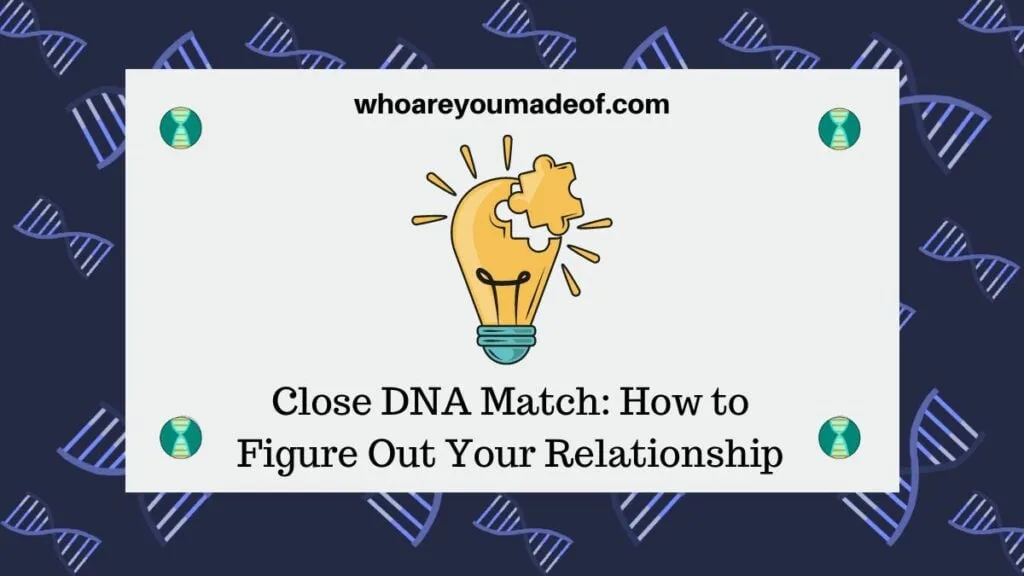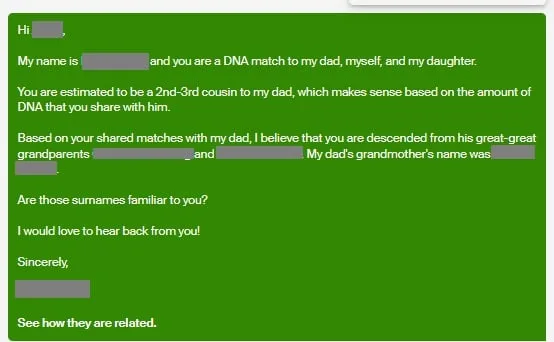Do you have a close DNA match with whom you would like to figure out your relationship? In this post, learn some strategies that you can use to find out how you are related to those closer DNA matches.

It might seem like it should be very easy to figure out how a close DNA match is related. After all, sharing a higher portion of DNA limits the relationship possibilities.
However, every DNA match case is different. Some people don't know who one or more of their biological parents are, or have access to limited family tree information for other reasons.
The difference between a "good match" and a "close match"
For this post, I decided to use an example from a DNA match that I recently worked on for one of my close relatives. I discovered this relative through my dad's DNA matches, noting that they shared 322 cMs (centimorgans) on Ancestry.
After examining the matches that the match shared in common with my father, I was able to determine that this match was probably related to my dad through his great-grandparents. I wrote to the match and provided a few details about how I thought they might be related, asked a few questions about their family tree, and also suggested that they upload their DNA to Family Tree DNA or Gedmatch.
I suggested that they upload to Gedmatch because my great-uncle had uploaded his DNA to the site, and I knew that this would provide me with an additional data point to determine their relationship. The match shared 708 cMs with my dad's uncle.
While the 322 cMs the match shared with my dad indicates a pretty good match, I consider 708 cMs to be a close match. Below, find out how I discovered how my great-uncle and his 708 cM match are related.
Decide relationship possibilities
At the time that I discovered this new DNA match for my great-uncle, who passed away in his 90s with no known descendants, his estate was in probate. When I saw a 708 cM DNA match, I knew that there was a possibility that this match could be a descendant - and this would be important information to know for his estate.
I used the Shared cM tool on DNA Painter to see which family relationships were possible at 708 cMs. The options were:
- great-grandparent
- great-great aunt/uncle
- great-aunt/uncle
- half-aunt/uncle
- first cousin
- half-first cousin
- half-niece/nephew
- first cousin once-removed
- great-niece/nephew
- great-great niece/nephew
- great-grandchild
Due to the age of my great-uncle (90s), I was able to eliminate great-grandparent, great-great aunt/uncle, and great-aunt/uncle from the list of possibilities. It would be impossible for those relatives to still be living.
Theoretically, it would be possible for an unknown half-aunt/uncle to still be alive. However, based on my analysis of the DNA matches that my dad shared with our relative on Ancestry, I knew that my great-uncle shared both of his grandparents in common with the match.
This helped me eliminate all of the "half" relationships from the list. The remaining relationship possibilities looked like this:
- first cousin
- first cousin once-removed
- great-niece/nephew
- great-great niece/nephew
- great-grandchild
It's always very helpful in cases like this to have DNA information from more than one relative to compare to a match. In this situation, I knew that my dad shared 322 cMs with the match, which helped me eliminate the possibility that the match was my great-uncle's great-niece/nephew.
First cousins typically share at least 600-1300 cMs, so I knew that this match was not a full first cousin to my father. The full list of possibilities was now whittled down this:
- first cousin once-removed
- great-niece/nephew
- great-great niece/nephew
- great-grandchild
Without information from the DNA match, or a corresponding family tree, this is as far as we could get with only DNA and shared matches. I knew that the match could be one of those four relationships to my great-uncle, and that they were descended in some way from my great-uncle's grandparents.
Message the match
As I mentioned before, one of the things that I did early on in my research was send my DNA match a message. The information that my relative provided in response ended up being a big help in solving how they are related to my great-uncle.
Below is the message that I sent. I follow a similar format when I message most of my matches, and I usually get responses, even when my matches don't know very much about their family tree.

Fortunately, the match responded to my message and provided me with information that helped me eliminate even more relationship possibilities. My relative said that they had been adopted at birth, and told me their year of birth, and also where they were born in the US.
As a refresher, these were the remaining relationship possibilities at this point:
- first cousin once-removed
- great-niece/nephew
- great-great niece/nephew
- great-grandchild
However, the year of birth the DNA match gave me meant that they are currently in their 60s. My great-uncle was born in the late 1920s, making it essentially impossible that he have a great-grandchild who was already over the age of 60.
I could now eliminate the possibility that my new relative is descended from my great-uncle, as I didn't think he is old enough to be their great-grandfather. Great-grandchild was the only relationship possibility that was in the category of descendant.
I also decided that it was unlikely, while not impossible that the match was a great-niece/nephew or a great-great niece/nephew. My great-uncle's parents only had three children: my great-uncle, my grandfather, and my great-aunt.
If the match was descended from my grandfather with a relationship of great or great-great niece or nephew to my great-uncle, they would have shared more than 322 cMs with my dad. If the match was descended from my great-aunt with these relationships to her brother, it would have meant that she would have had a child that we didn't know about.
So, I finally decided that first cousin once-removed to my great-uncle was the correct relationship. I mentioned this to my relative, who in this case would be my second cousin once-removed.
I didn't hear anything back for about a year and a half, and then I got a message saying thanks, as well as a bit of information that they had learned about the potential identity of their biological father.
However, I felt like the mystery was "solved", at least for a while. At least I knew how my great-uncle was related, even if I didn't know exactly who my relative's father was.
The mystery is solved
One day, I started thinking about this DNA match again. I realized that if I had the skills to help my match figure out exactly who their biological father was, I had to do it.
Plus, what if there were siblings still alive? I needed to help while there was still time for potential family members to connect with each other, if that's what they decided to do.
So, I sat down again with all of the information and took another look at it all. I thought that I knew the identities of all of the cousins of my great-uncle, and I knew that one of them was the father of the DNA match.
However, none had the last name that my cousin provided me in their most recent message.
On a whim, I did an Ancestry search with the last name that my cousin gave me as the last name on Ancestry, and I put the last name that I expected the match to have in the "keyword" box on Ancestry. I put in the approximate birth year, and limited the search to the United States.
My match was born in Oregon, and the top result was a death certificate from Washington. Upon further examination, I saw that the death certificate listed one of my great-granduncles (great-great uncle) as their father.
My great-granduncle would have been my great-uncle's uncle. Their child would have been my great-uncle's first cousin, making their child, the DNA match, my great-uncle's first cousin once-removed.
The mystery was solved, and I messaged my cousin with the news. Of course, they were overjoyed because they had long since given up the hope of ever knowing who their biological father was.
Now, they knew his identity. The reason that it had been so difficult to figure out the connection was because their father had taken on the name of his step-father early in life, thereby erasing the his biological father's surname from his records.
However, the person who reported the information for his death certificate (his spouse) did report the name of his parents, which truly helped solve this mystery.
Conclusion
I really enjoyed helping my cousin find out who their father was, and I'm glad I was able to do it. All of the research that I did for this was something that anyone who is reading this can learn how to do.
It doesn't require any special skills, but it does require attention to detail and of course, the understanding of how to use the amount of DNA that we share with someone to estimate our family relationships. I've written many articles about how to understand and use DNA matches, and they are all free to read.
I used a combination of DNA details from more than one person's results, as well as a my family tree, and information gathered from my DNA match to solve this mystery. It is important to get as many details as you can to help you in your own journey solving DNA match mysteries.
A few identifying details were changed in this post to protect my relative's privacy.
If you have any questions about something that you read here, or if you would like to ask a specific question about a close match, I would love to hear from you in the discussion below.
Thanks for stopping by today!

Patricia Macy
Sunday 9th of June 2024
You write that based on your analysis of the DNA matches that you and your Dad share with the relative you knew that your great uncle shared both of his grandparents with the match. My sister-in-law is adopted and had a 767 cM match on Ancestry. This match is called Parent 2 I have sketched out all of her other Parent 2 matches down to about 50 cM match. (I did the same for Parent 1’s matches’ trees for the other parent although the closest match on that side is 473 cM.
I’m able to see the overlaps between the various trees for each side.
I am not sure I have anything intelligent to say to her matches about how I think she may match them. Can you direct me to a possible next step?
Thank you, Patricia Ketterer Macy